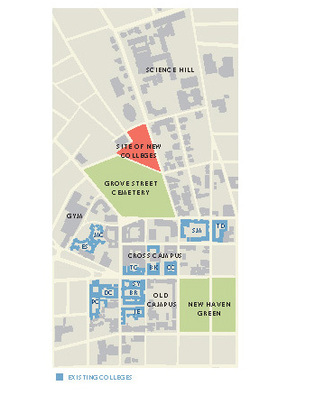 loading
loading
Light & VerityYale College to expand enrollment by 15 percent Mark Zurolo ’01MFAThe new residential colleges will be built north of the Grove Street Cemetery, near Science Hill but farther from traditional campus centers than the existing colleges. View full imageIt's official: Yale will build two new residential colleges and expand its undergraduate enrollment by 15 percent, the university announced on June 7. Yale's governing board, the Yale Corporation, formally approved the plan at its regular June meeting. In a letter to alumni, President Richard Levin said that the university has already raised $140 million in gifts and pledges toward the new colleges, and that the goal of the current university fund-raising campaign has been changed from $3 billion to $3.5 billion to accommodate the new building plans. He also said that the colleges are expected to open in 2013. The Corporation's decision was long expected. Ever since the university's expansion proposal became public in the fall of 2006, insiders have suggested that the plan was a done deal. A study group convened last year considered the implications of expansion and solicited opinions from the Yale community, but the question all along seemed less whether to expand than how. The most vocal objection to the idea came from current undergraduates, some of whom expressed concern that even a modest expansion would reduce the intimacy of the Yale College experience. Levin cited Yale's increasing selectivity as a reason for the decision to expand. Because the number of people applying to Yale has doubled in recent years, the college now admits fewer than 10 percent of candidates who apply. "Admissions officers agree that in each of the past several years we have denied admission to hundreds of applicants who would have been admitted ten years ago," Levin writes. The expansion will "allow us to make an even greater contribution to society by preparing a larger number of talented and promising students of all backgrounds for leadership and service." Yale's most recent freshman class had 1,320 students. A 15 percent increase would add about 200 students to that total and eventually increase the overall undergraduate population from 5,275 to just over 6,000. Levin writes that the faculty will also be expanded "to sustain our favorable ratio of students to teachers, particularly in highly subscribed majors." In addition to expanding enrollment, the new colleges will allow Yale to reduce the population of the existing residential colleges by about 140 students overall, alleviating overcrowding and the need to house students in annex housing outside the colleges. The new colleges will be built north of the Grove Street Cemetery near Science Hill, on a Yale-owned site bounded by Prospect, Sachem, and Canal streets. In public forums over the past year, Yale undergraduates expressed skepticism about the site's remoteness from what they view as the core of the campus. But Levin writes that the colleges in fact will "alter the perception that Science Hill is 'too far away' from the 'center' of campus. . . . The new colleges have the potential of making the whole campus seem smaller." He adds that improvements to Prospect Street and student-activity spaces on or near the site—as recommended in the study group's report—will help make the area more attractive. The announcement did not address the issue of what the new colleges will be called. Levin has already said, though, that they will not be named for donors but will continue in the tradition of the other 12 colleges, which are named for people and places in the university's history.
The comment period has expired.
|
|